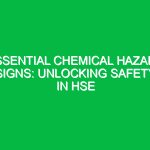Introduction
Chemistry Hazard Symbols are critical visual cues that communicate the risks associated with chemical substances. These symbols are vital in the Health, Safety, and Environment (HSE) domain, aiding in the identification of potential Hazards in laboratories, industrial settings, and even in household products. Understanding these symbols is not just a regulatory requirement; it’s a fundamental aspect of ensuring Safety in environments where chemicals are handled. By unpacking the meanings behind these symbols, we can foster a culture of Safety that protects workers and the environment alike.
The Importance of Chemistry Hazard Symbols in HSE
The role of chemistry hazard symbols transcends mere compliance with Regulations; they serve as an immediate visual communication tool that can avert accidents and save lives. For example, the skull and crossbones symbol alerts individuals to the presence of toxic substances, while the flame symbol indicates flammable materials. This clear communication is essential in high-stakes environments like chemical plants, laboratories, and even during transportation of hazardous materials.
Moreover, these symbols play a crucial role in Training and education. They equip workers with the knowledge needed to recognize Hazards and respond appropriately. A well-informed workforce is a key asset in minimizing accidents and ensuring compliance with safety protocols.
Understanding Common Chemistry Hazard Symbols
To effectively navigate the world of chemistry hazard symbols, it’s essential to familiarize oneself with the most common symbols used in the HSE context. Below are some of the key symbols and their meanings:
- Flame: Indicates flammable materials and substances that can ignite easily.
- Skull and Crossbones: Signifies toxic substances that can cause severe health issues or death.
- Exclamation Mark: Represents a general hazard, including irritants and allergens.
- Corrosion: Denotes materials that can corrode metals or cause skin damage.
- Environmental Hazard: Indicates substances that may pose a risk to aquatic environments.
Each symbol is designed to be easily recognizable, allowing individuals to quickly assess the risks associated with a particular chemical. For instance, during a routine inspection at a chemical facility, a worker might encounter containers labeled with the flame symbol. This immediate recognition prompts them to take extra Precautions, such as wearing flame-resistant clothing and ensuring that no open flames are present.
Best Practices for Using Chemistry Hazard Symbols
Incorporating chemistry hazard symbols into daily operations requires a proactive approach. Here are some Best Practices to enhance safety:
- Training and Education: Regular training sessions should be held to educate employees about the meanings of various hazard symbols. This fosters a culture of safety and ensures that everyone understands the risks involved.
- Proper Labeling: Ensure that all chemical containers are correctly labeled with hazard symbols. This includes not only the primary hazard but also any additional risks that may be associated with the chemical.
- Emergency Procedures: Establish clear emergency procedures that include how to respond to incidents involving hazardous chemicals. This should be communicated to all employees.
- Regular Audits: Conduct regular audits of chemical storage areas to ensure compliance with labeling and safety protocols. This helps identify any potential hazards before they become issues.
By integrating these Best Practices, organizations can significantly reduce the risk of chemical-related accidents and promote a safer working environment.
Potential Hazards and Risks Associated with Chemistry Hazard Symbols
While chemistry hazard symbols are designed to inform and protect, it is essential to recognize the potential hazards associated with the chemicals they represent. For example, a substance labeled with the corrosion symbol indicates that it can cause severe Burns upon contact with skin. Without proper protective equipment, workers are at risk of serious injuries.
Additionally, the exclamation mark symbol, which denotes irritants, may lead to chronic health issues if exposure is not managed. In a case reported by the Occupational Safety and Health Administration (OSHA), workers exposed to irritant chemicals in a poorly ventilated area developed respiratory problems due to inadequate protective measures.
Understanding these risks emphasizes the need for comprehensive safety protocols that include proper training, the use of Personal Protective Equipment (PPE), and strict adherence to Safety Guidelines. Regular safety drills can also prepare employees for potential incidents, ensuring they know how to react effectively.
Regulations and Standards Governing Chemistry Hazard Symbols
Chemistry hazard symbols are governed by various regulations and standards that ensure safety in the workplace. Key regulations include:
- Globally Harmonized System (GHS): This system standardizes Hazard Communication globally, ensuring that symbols convey the same meaning across different countries.
- Occupational Safety and Health Administration (osha): OSHA mandates proper labeling of hazardous chemicals and provides guidelines for communicating these hazards to workers.
- Environmental Protection Agency (EPA): The EPA regulates chemicals that pose risks to the environment, requiring proper labeling to prevent environmental damage.
Compliance with these regulations is crucial for organizations, as failure to adhere can result in significant fines and legal repercussions. Moreover, it can compromise the safety of employees and the surrounding community.
Real-Life Examples and Case Studies
Understanding the real-world implications of chemistry hazard symbols can provide valuable insights. For instance, consider a chemical manufacturing facility where improper labeling led to a severe incident. A worker mistakenly mixed two reactive chemicals because the containers lacked proper hazard symbols. The resulting reaction caused an explosion, injuring several employees and leading to substantial property damage.
This incident underscores the importance of clear labeling and effective communication. In response, the facility implemented a comprehensive training program focused on hazard symbols, conducted regular safety drills, and established a culture of communication where employees felt empowered to report unsafe conditions.
Conclusion
In conclusion, chemistry hazard symbols are more than just regulatory requirements; they are essential tools for promoting health, safety, and environmental Sustainability. By understanding these symbols and the risks they represent, organizations can foster safer working environments and minimize the chance of accidents. It is imperative for businesses to prioritize training, proper labeling, and adherence to regulations to protect their employees and the environment.
As we move forward, let us continue to advocate for robust safety practices and a culture of awareness surrounding chemistry hazard symbols. By doing so, we can contribute to a safer and healthier future for everyone involved in the handling of chemicals.


